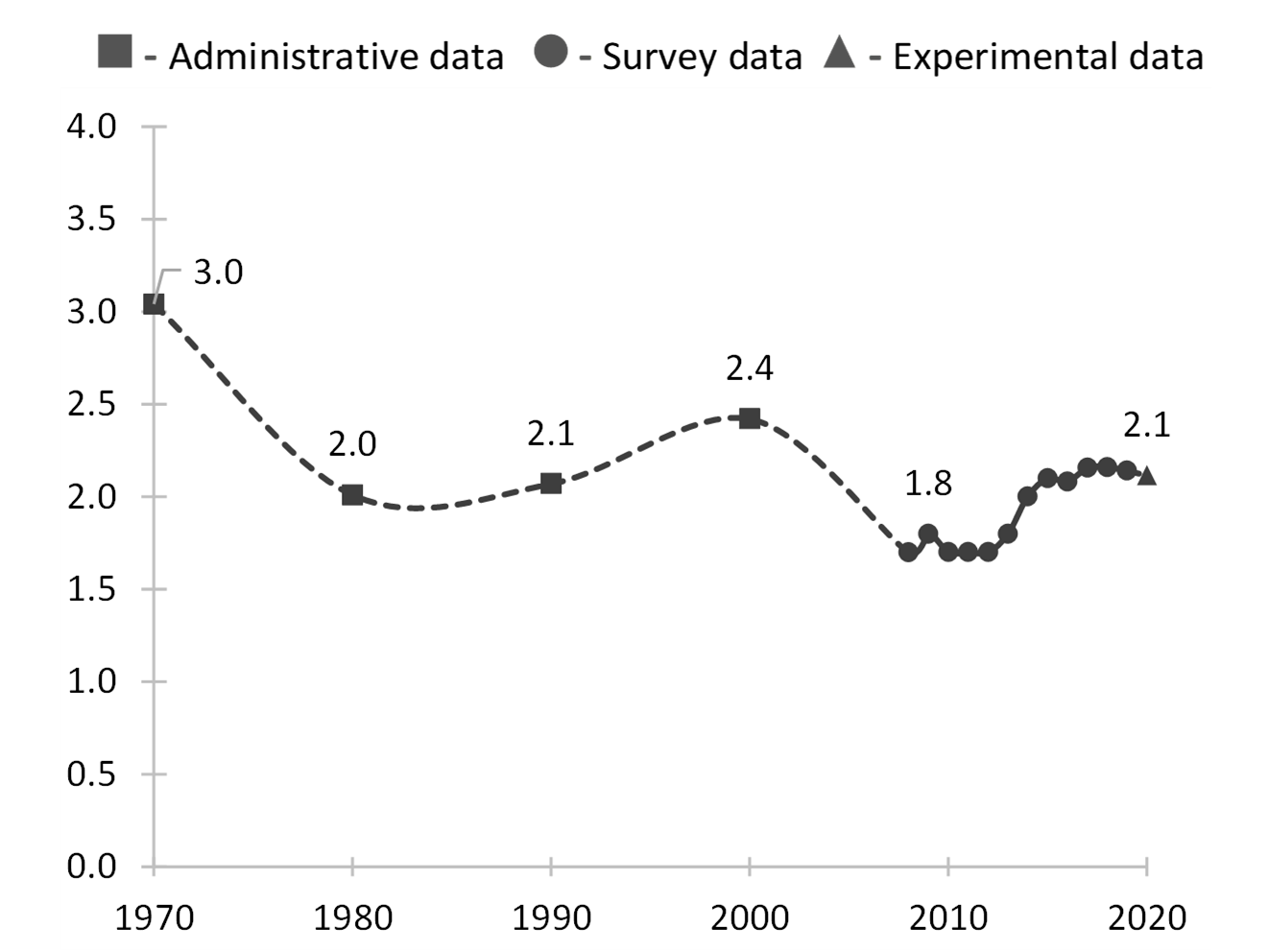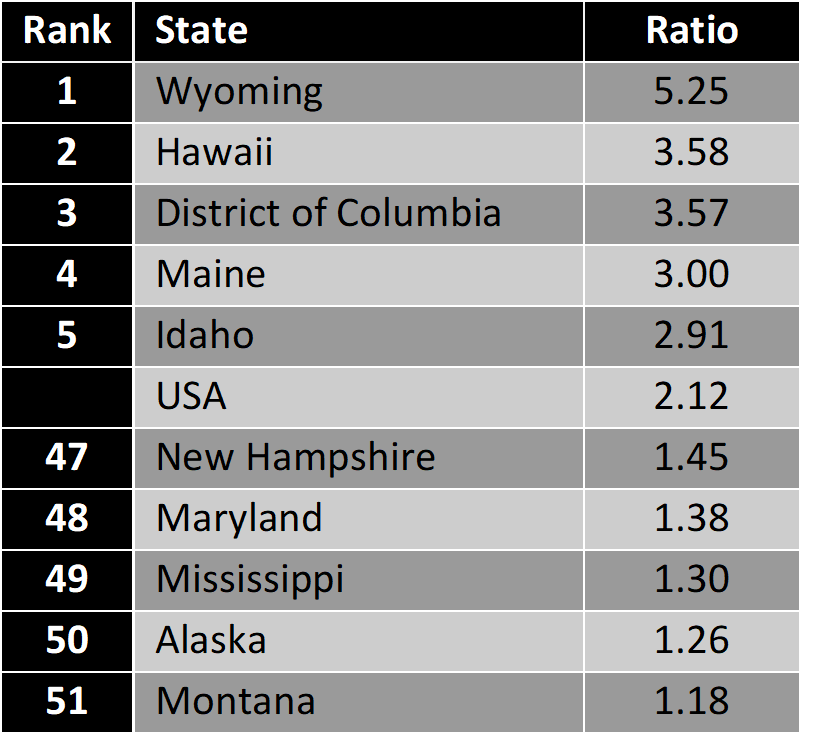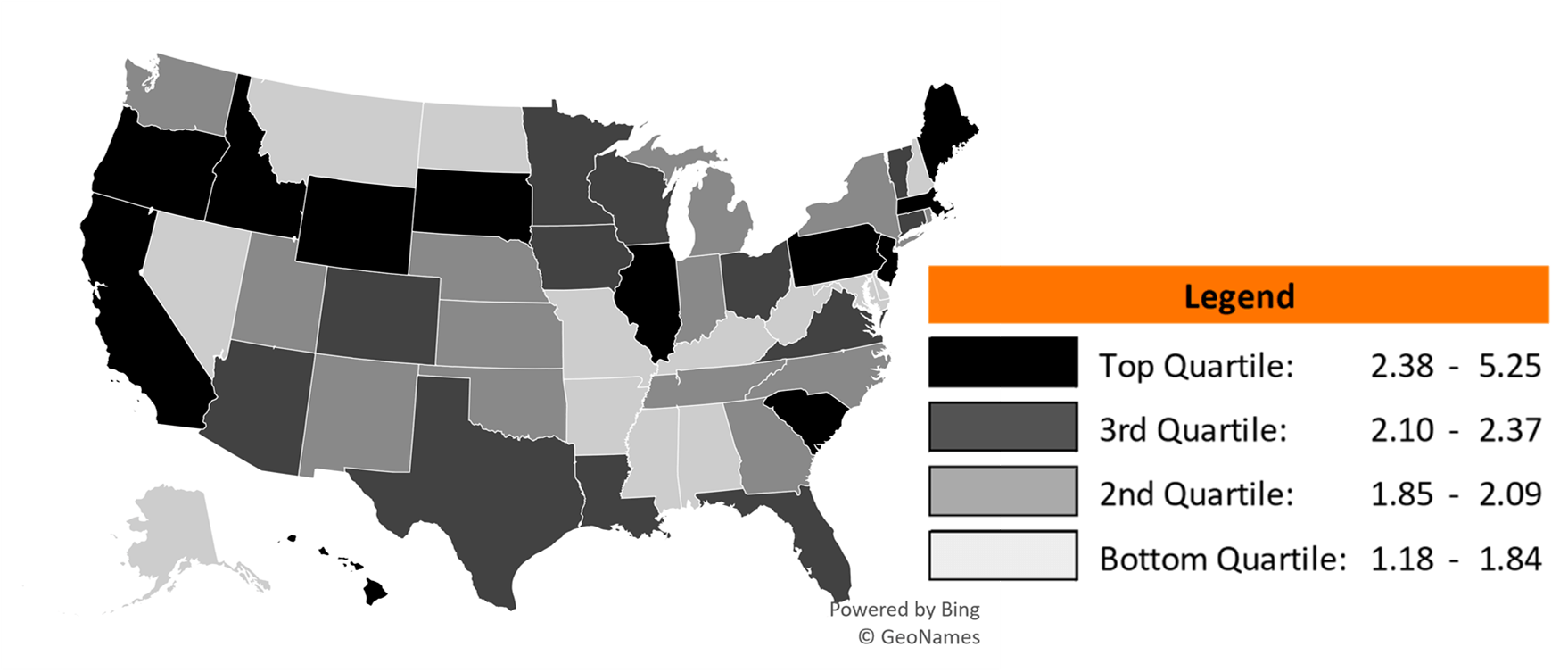Marriage-to-Divorce Ratio in the U.S.: Geographic Variation, 2020
Family Profile No. 09, 2022
Author: Krista K. Westrick-Payne

This family profile updates previous profiles on the marriage-to-divorce ratio (FP-20-26; FP-19-24; FP-19-03; FP-17-01; FP-15-19) and examines state variation in the ratio of marriages to divorces. Please note, the standard 2020 ACS 1-year data products will not be released due to the impact from the COVID-19 pandemic on data collection and data quality (for more information click here). As such, the estimates in this report for the year 2020 were derived from NCFMR analyses of ACS 1-year Experimental PUMS data. We calculate national and state level marriage-to-divorce ratios by dividing the number of women’s marriages by the number of women’s divorces in a given year.
The Marriage-to-Divorce Ratio, 2020
- In 2020, there were approximately two marriages per every one divorce in the United States (ratio = 2.12). Specifically, there 2,031,107 marriages and 960,014 divorces.
- The ratio has remained stable since 2014, when it was also approximately two marriages for every one divorce (FP-15-19).
Figure 1. Women’s Marriage-to-Divorce Ratios, 1970 to 2020

Five Highest and Lowest Marriage-to-Divorce Ratios, 2020
- All states had a greater number of marriages than divorces. Wyoming (5.25), Hawaii (3.58), and District of Columbia (3.57) were the top three states in the marriage-to-divorce ratio in 2020. There were at least 3.5 marriages per every one divorce in these states.
- The states with the lowest marriage-to-divorce ratios were Montana (1.17), Alaska (1.26), and Mississippi (1.30).
Figure 2. Women's Highest and Lowest Marriage-to-Divorce Ratios, 2020

State Rankings, 2020
- Among states in the Northeast, the ratios of most states fell in the top (fourth) quartile (44%), meaning they had some of the largest ratios of marriages-to-divorces in 2020.
- For those in the Western region of the U.S., their ratios most often fell in the top quartile (38%).
- Among states in the South, they were most often found in the bottom (first) quartile (41%), meaning they had some of the smallest ratios of marriages to divorces in 2020.
- Midwestern states tended to cluster in the two middle quartiles, with one-third of their states in each.
Figure 3. State-level Marriage-to-Divorce Ratios Among Women Aged 15+ by Quartile, 2020

Figure 4. Geographic Variation in Marriage-to-Divorce Ratios Among Women Aged 15+, 2020

References:
Clarke, S. C. (1995). Advance Report of Final Marriage Statistics, 1989 and 1990. Monthly Vital Statistics Report, (43)12. National Center for Health Statistics. http://www.cdc.gov/nchs/data/mvsr/supp/mv43_12s.pdf
National Center for Health Statistics (1974). Summary Report Final Marriage Statistics, 1970. Monthly Vital Statistics Report, Vol. 23, No. 2, Supp. 1. U.S. Department of Health, Education, and Welfare. http://www.cdc.gov/nchs/data/mvsr/supp/mv23_02s1acc.pdf
National Center for Health Statistics (1983). Advance Report of Final Marriage Statistics, 1980. Monthly Vital Statistics Report, Vol. 32, No. 5, Supp. U.S. Department of Health and Human Services. http://www.cdc.gov/nchs/data/mvsr/supp/mv32_05s.pdf
National Center for Health Statistics (2001). Births, Marriages, Divorces, and Deaths: Provisional Data for January-December 2000. National Vital Statistics Reports, Vol. 49, No. 6. Associated Table 3. Department of Health and Human Services, Centers for Disease Control and Prevention. http://www.cdc.gov/nchs/data/nsvr/nsvr49/49_06_12_03.pdf
Reynolds, L. R. (2020). Marriage to Divorce Ratio in the U.S.: Geographic Variation, 2019. Family Profile, (FP-20-26). National Center for Family & Marriage Research. https://doi.org/10.25035/ncfmr/fp-20-26
Schweizer, V. (2019). Marriage to Divorce Ratio in the U.S.: Geographic Variation, 2018. Family Profile, (FP-19-24). National Center for Family & Marriage Research. https://doi.org/10.25035/ncfmr/fp-18-24
Suggested Citation:
Westrick-Payne, K. K. (2022). Marriage-to-divorce ratio in the U.S.: Geographic variation, 2020. Family Profile, (FP-22-09). National Center for Family & Marriage Research. https://doi.org/10.25035/ncfmr/fp-22-09
Updated: 11/12/2025 10:10AM


